(no subject)
the Japanese Garden was really cool. it’s pretty hard to really explain it so I’m going to use the brochure to give you guys a tour:
Created for rest and repose the Japanese Garden in Portland's west hills is a 5.5 acre form garden featuring five garden styles: Tea Garden, Strolling Pond Garden, Natural Garden, Sand and Stone Garden, and Flat Garden.
Japanese gardens have an ancient history influenced by Shinto, Buddhist and Taoist philosophies. Upon entering a Japanese garden the hope is to realize a sense of peace, harmony and tranquility. Three primary elements are used in every garden design: stone, the "bones" of the landscape, water, the life-giving force, and plants, the tapestry of the four seasons. Other important elements include pagodas, stone lanterns, water basins, arbors and bridges. The most symbolic plants for a Japanese garden are pine, bamboo and plum which connote good fortune.
The Garden is asymmetrical in design and reflects nature in a stylized form. Human scale is maintained throughout so that the visitor always feels part of the environment rather than being overpowered by it. The Eastern symbolism challenges the visitor to reflect and to be open to varying interpretations of sights and sounds. This is a place to discard worldly thoughts and concerns and see oneself as a small but integral part of the universe.
1 - After passing through the Admission Gate you will see a pine and water basin arrangement. The pine trees symbolize strength and longevity. In Japan the water basin is used to rinse one's hands and mouth symbolically purifying oneself. This rite is usually performed before entering a shrine or tea house.
the bamboo helps the tree to form a certain way:

2 - Step through the Wisteria Arbor (though of course it's not in bloom since it's winter)
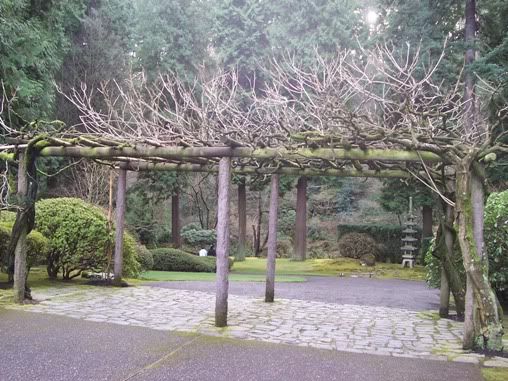
that was designed as a frame for the antique 5-tiered stone pagoda

given to Portland from its Sister City, Sapporo, Japan. The stones at the base of the Pagoda are in the shape of the island of Hokkaido, with Sapporo designated by the red stone to the upper left.
3 - The Strolling Pond Garden. To the north is the Upper Pond,
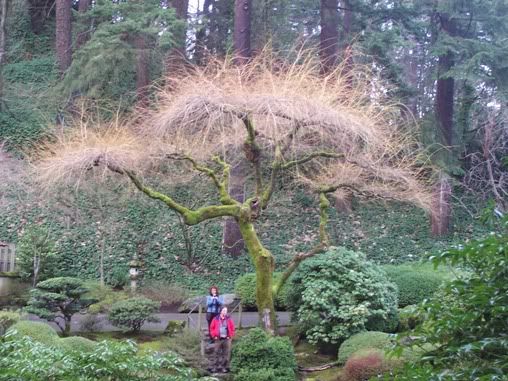
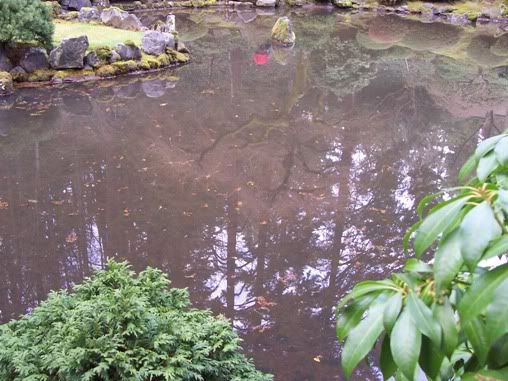
featuring the authentic Moon Bridge. To the south is the creek and the Lower Pond, which holds tortoise and crane stones, common symbols of longevity. The Zig Zag Bridge leads through the iris beds to the Heavenly Falls.
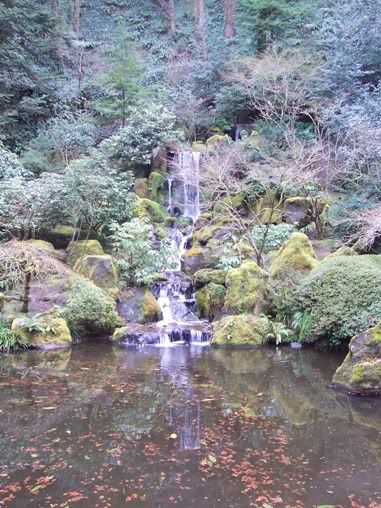

4 - The Tea Garden consists of two gardens. The Inner Garden surrounds the ceremonial Tea House. The Outer Garden contains the watering station for guests. Our Tea House, called kashin-tei or Flower Heart House, was built in Japan using the traditional construction method.
5 - The Natural Garden winds its way down the south hillside. Discover ponds, waterfalls, and shallow streams as they meander under tiny bridges. Trees, shrubs, ferns and mosses grow in their natural state. The tile-roofed gazebo provides a place for reflection.


6 - The Sand and Stone Garden
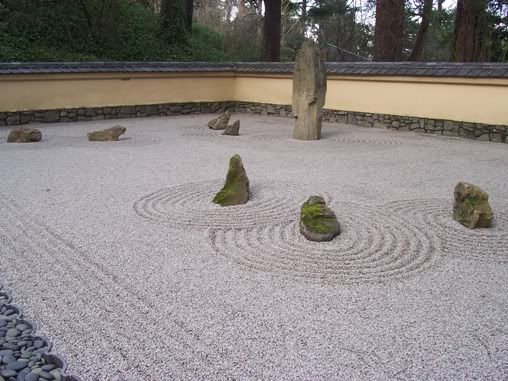
is the most abstract of the Japanese Garden forms. It features the stark simplicity of weathered stones rising from a bed of sand ripple raked to suggest the sea. This garden style is typically found in Zen monasteries.





7 - The Poetry Stone,
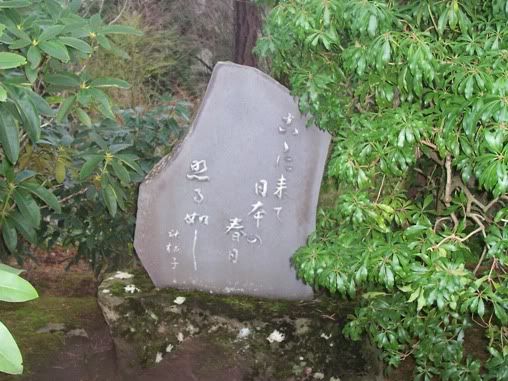
located south of the Pavilion is inscribed with haiku (traditional Japanese poem). Loosely translated it reads, "Here, miles from Japan I stand as if warmed by the spring sunshine of home."
view of Portland:
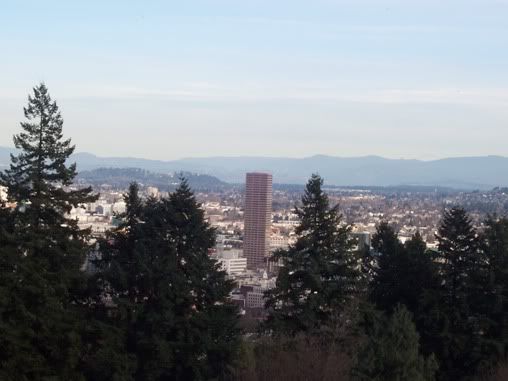

view of Sand and Stone Garden from above:

8 - The Pavilion is used for society events and business. Architectural features include shoji (translucent paper panels), fusuma (paper-covered movable wall panels), tatami (reed mats) and verandas that connote the integration of house and garden. This architectural style is from the Kamakura period in Japan.
9 - The Flat Garden
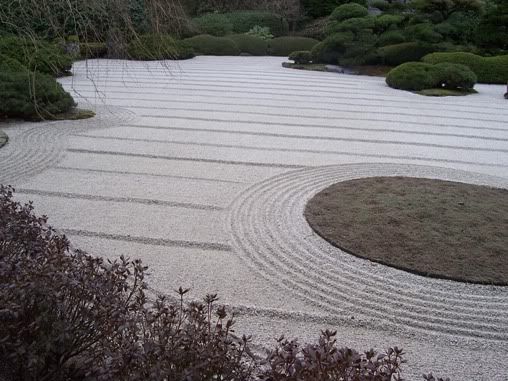

is designed using a sea of raked sand. The two islands of plantings depict a sake cup and gourd-shaped bottle, signifying pleasure and a wish for the visitor's happiness.
Created for rest and repose the Japanese Garden in Portland's west hills is a 5.5 acre form garden featuring five garden styles: Tea Garden, Strolling Pond Garden, Natural Garden, Sand and Stone Garden, and Flat Garden.
Japanese gardens have an ancient history influenced by Shinto, Buddhist and Taoist philosophies. Upon entering a Japanese garden the hope is to realize a sense of peace, harmony and tranquility. Three primary elements are used in every garden design: stone, the "bones" of the landscape, water, the life-giving force, and plants, the tapestry of the four seasons. Other important elements include pagodas, stone lanterns, water basins, arbors and bridges. The most symbolic plants for a Japanese garden are pine, bamboo and plum which connote good fortune.
The Garden is asymmetrical in design and reflects nature in a stylized form. Human scale is maintained throughout so that the visitor always feels part of the environment rather than being overpowered by it. The Eastern symbolism challenges the visitor to reflect and to be open to varying interpretations of sights and sounds. This is a place to discard worldly thoughts and concerns and see oneself as a small but integral part of the universe.
1 - After passing through the Admission Gate you will see a pine and water basin arrangement. The pine trees symbolize strength and longevity. In Japan the water basin is used to rinse one's hands and mouth symbolically purifying oneself. This rite is usually performed before entering a shrine or tea house.
the bamboo helps the tree to form a certain way:

2 - Step through the Wisteria Arbor (though of course it's not in bloom since it's winter)

that was designed as a frame for the antique 5-tiered stone pagoda

given to Portland from its Sister City, Sapporo, Japan. The stones at the base of the Pagoda are in the shape of the island of Hokkaido, with Sapporo designated by the red stone to the upper left.
3 - The Strolling Pond Garden. To the north is the Upper Pond,


featuring the authentic Moon Bridge. To the south is the creek and the Lower Pond, which holds tortoise and crane stones, common symbols of longevity. The Zig Zag Bridge leads through the iris beds to the Heavenly Falls.


4 - The Tea Garden consists of two gardens. The Inner Garden surrounds the ceremonial Tea House. The Outer Garden contains the watering station for guests. Our Tea House, called kashin-tei or Flower Heart House, was built in Japan using the traditional construction method.
5 - The Natural Garden winds its way down the south hillside. Discover ponds, waterfalls, and shallow streams as they meander under tiny bridges. Trees, shrubs, ferns and mosses grow in their natural state. The tile-roofed gazebo provides a place for reflection.


6 - The Sand and Stone Garden

is the most abstract of the Japanese Garden forms. It features the stark simplicity of weathered stones rising from a bed of sand ripple raked to suggest the sea. This garden style is typically found in Zen monasteries.





7 - The Poetry Stone,

located south of the Pavilion is inscribed with haiku (traditional Japanese poem). Loosely translated it reads, "Here, miles from Japan I stand as if warmed by the spring sunshine of home."
view of Portland:


view of Sand and Stone Garden from above:

8 - The Pavilion is used for society events and business. Architectural features include shoji (translucent paper panels), fusuma (paper-covered movable wall panels), tatami (reed mats) and verandas that connote the integration of house and garden. This architectural style is from the Kamakura period in Japan.
9 - The Flat Garden


is designed using a sea of raked sand. The two islands of plantings depict a sake cup and gourd-shaped bottle, signifying pleasure and a wish for the visitor's happiness.